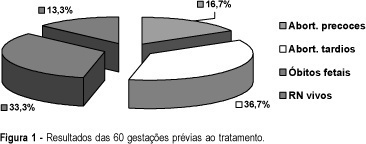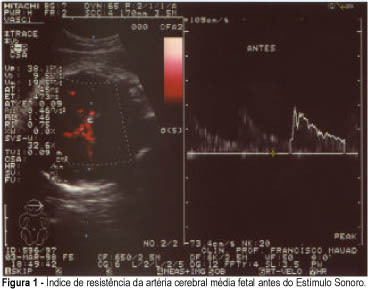Summary
Revista Brasileira de Ginecologia e Obstetrícia. 1999;21(4):215-221
DOI 10.1590/S0100-72031999000400006
Purpose: to determine the effectiveness and the safety of treatment with heparin and low-dose aspirin in pregnant women with antiphospholipid syndrome, and to determine possible deteriorating factors for this syndrome. Methods: 17 patients with antiphospholipid syndrome were submitted to a rigorous antenatal care. Patients were treated with a fixed dose of heparin (10,000 IU/day) associated with low-dose aspirin (100 mg/day). We analyzed perinatal and maternal results, using chi² test and Fischer's exact test. Results: the overall live birth rate was 88.2% in treated pregnancies of these patients versus 13.3% of their previous nontreated pregnancies. The incidence of adverse pregnancy outcomes was very significant: oligohydramnios (40%), fetal distress (33.3%), fetal growth retardation (33.3%), gestational diabetes (29.4%), preeclampsia(23.5%), and preterm delivery (60%). The presence of systemic lupus erythematosus was an indication of poor prognosis. No significant side effects were observed during the treatment. Conclusions: this treatment was effective to improve live birth rate, safe, but it was not able to avoid adverse pregnancy outcomes associated with antiphospholipid syndrome. Systemic lupus erythematosus was a deteriorating factor for this syndrome.

Summary
Revista Brasileira de Ginecologia e Obstetrícia. 1999;21(4):209-214
DOI 10.1590/S0100-72031999000400005
Purpose: to develop an experimental model in rats to study the interaction between hypertension and pregnancy. Methods: the present experiment was divided into 5 periods: adaptation (2 weeks), surgical procedures (1 week), hypertension development (6 weeks), mating and blood pressure stabilization (6 weeks), and gestational period (3 weeks). A total of 82 animals in reproductive age, weighing from 180 to 240 g, were used. They were randomly assigned to the 4 different groups (control, handled, nephrectomy and hypertension) and renal hypertension was produced by a controlled constriction of the main left renal artery, according to the technique described by Goldblatt, and contralateral nephrectomy (Goldblatt I - one kidney, one clip hypertension). They were studied at 15 precise moments. Afterwards, periodic blood pressure determinations were made by the tail plethysmographic method. Results: pregnancy caused a fall in blood pressure levels in the rat. Conclusion: the experimental model was adequate for the purposes of the study, since it proved to be efficient in producing hypertension.

Summary
Revista Brasileira de Ginecologia e Obstetrícia. 1999;21(4):201-205
DOI 10.1590/S0100-72031999000400004
Purpose: evaluation of the risk factors [lesion grade, seropositivity for type 1 acquired immunodeficiency virus (HIV-1) and association with pregnancy ] for relapse of human papillomavirus (HPV) induced lesions of the female genital tract. Patients and Methods: seventy patients with a clinical, colposcopic and cytologic diagnosis of HPV infection were studied. Clinical follow-up lasted at least 6 months after the initial treatment, thus permitting the evaluation of the therapeutic results. Twenty-seven of these patients were pregnant and 12 were seropositive for HIV-1. The remaining 44 patients were not in the pregnancy-puerperium cycle and 14 of them were HIV-1 positive. According to cytologic criteria, the cervical lesions were classified as changes associated with HPV or grade I cervical intraepithelial neoplasia (CIN I) (low grade lesions) or CIN II/III (high grade lesions). Data were analyzed statistically by the exact Fisher test, with the level of significance set at p<0.05. The therapeutic scheme for lesions limited to the uterine cervix was cryo- or electrocautery (EC), whereas topical 5-fluorouracil was used for the diffused lesions through the vaginal wall. For the lesions in the vulvoperineal region, 80% trichloroacetic acid was used, and when they were voluminous, EC was applied. Among the pregnant women, a cryocautery was used for lesions limited to the cervix and EC for diffuse lesions. Results: among the HIV-1-negative pregnant women there was an 87.5% rate of recurrence when the lesions were in the cervix-vagina, and no recurrence when the lesions were vulvoperineal. In contrast, seropositive pregnant women presented 100% recurrence regardless of the site of the lesion. Among nonpregnant HIV negative women, 20 and 24% recurrence was observed in the cervix-vagina and in the vulvoperineal region, respectively, as opposed to 87.5 and 100% recurrence, respectively, for the same regions among HIV positive women. The lesions associated with CIN showed a higher frequency of recurrence with increasing CIN grade and a synergistic effect with the association of HIV-1 and pregnancy. Conclusions: the recurrence rate for women treated for HPV-induced lesions is high and the association with pregnancy, HIV and increased grade of the intraepithelial lesions are synergistic factors in the determination of therapeutic failure. The site of implantation of HPV-induced lesions is of prognostic significance only when the infection is not associated with HIV.
Summary
Revista Brasileira de Ginecologia e Obstetrícia. 1999;21(4):193-200
DOI 10.1590/S0100-72031999000400003
Purpose: to evaluate the efficacy of cytology and colposcopy-directed biopsy to distinguish preclinical invasive cervical carcinoma from intraepithelial lesions. Patients and Methods: 441 patients submitted to conization, hysterectomy and Wertheim-Meigs operation from 1978 to 1995 in the University Hospital "Clementino Fraga Filho", Federal University of Rio de Janeiro, Cervical Pathology Outpatient Clinic. We estimated sensitivity, specificity, predictive values, likelihood ratio and confidence intervals of each study, which were divided into four classes: 1) normal and inflammatory; 2) mild and moderate dysplasias; 3) severe dysplasia and carcinoma in situ; 4) microcarcinoma and invasive carcinoma. Biopsies were analyzed as a whole and separated in accordance with the type of the colposcopic result (satisfactory and unsatisfactory). Results: cytology has shown sensitivity of 50%, specificity of 89%, positive predictive value of 63% and negative predictive value of 82%. The likelihood ratios were 4.4 for stromal invasion diagnosis, 0.7 for severe dysplasia and carcinoma in situ, 0.1 for mild and moderate dysplasia, 2.2 for normal and inflammatory report and 0.6 for the negative results for invasion as a whole. Satisfactory colposcopic guided biopsy white a visible lesion showed sensitivity of 59%, specificity of 100% positive predictive value of 100% and negative predictive value of 83%. Likelyohood ratios were: tending to infinity for invasion, 0.5 for severe dysplasia and carcinoma in situ, zero for mild and moderate dysplasia, zero for negative and inflammatory and 0.4 for all negative results for invasion.
Summary
Revista Brasileira de Ginecologia e Obstetrícia. 1999;21(3):133-137
DOI 10.1590/S0100-72031999000300003
Purpose: to evaluate how knowledgeable medical students at the Universidade Federal de Goiás were concerning the basic diagnostic principles breast cancer. The study also aimed at promoting a debate among the students and at assessing the understanding of the students in the fifth year of medical school, who had already attended the Gynecology course. Methods: Through questionnaires given to 348 individuals, from the first to the fifth year, out of a total population of 550 students, the authors searched for information with regard to basic knowledge on the diagnosis of breast cancer. Of the 348 questionnaires, 55 (16%) were given to fifth-year students, who had already attended the Gynecology course. Furthermore, 43% of the students were women, 62% had medical doctors in their immediate family, and 17% had a family history of breast cancer. Results: in regard to the knowledge of diagnostic methods, 84% of the students were aware of the most frequent sign of breast cancer, 34% knew which was the best screening method, 49% knew when to refer asymptomatic women to mammography, 37% knew the recommended interval between mammography for women above the age of 50, and 24% knew when to associate ultrasound to mammography for the detection of breast cancer. The fifth-year students provided correct answers at a significantly higher rate, when compared to the others. Concerning gender, the only difference regarded the fact that women showed a better knowledge as to the best time for self-examination and when to recommend ultrasound associated with mammography. The presence of medical doctors in the family and a history of family members with breast cancer did not have any influence on the answers. Conclusion: The lack of information in regard to the diagnosis of breast cancer is very high, even among medical students. Nevertheless, the rate of information increases significantly after students are taught Gynecology, which is only offered during the fifth year of the medical school.
Summary
Revista Brasileira de Ginecologia e Obstetrícia. 1999;21(3):161-165
DOI 10.1590/S0100-72031999000300007
Purpose: to evaluate the social, demographic and obstetrical profile of adolescents as compared with adult women hospitalized for abortion complications. Material and methods: this is a descriptive study that evaluated 230 women with abortion complications. Among them, 59 were adolescents hospitalized at the IMIP Maternity (Recife, Brazil) from August 1994 to July 1995. The variables studied were: educational level, marital status, any paid activity, gestation age, number of pregnancies, desire to become pregnant, use of anticonceptive method, kind of relationship, reason for voluntary interruption, clinical classification of abortion and associated complications. The procedure for data analysis was the distribution of variables among adolescents and adults, the differences being evaluated through chi² and chi² for trend. Results: compared with the adult women who aborted, the adolescents showed a lower number of paid activity and multiparity and a higher number of pregnancies resulting from an unstable relationship. Conclusions: the results indicated that biologicallly the adolescents who were hospitalized for abortion have a similar profile to adult women. What differentiates them are the unfavorable social and demographic conditions that they are faced with at their generally unplanned first pregnancies.
Summary
Revista Brasileira de Ginecologia e Obstetrícia. 1999;21(3):153-157
DOI 10.1590/S0100-72031999000300006
Purpose: to evaluate the efficacy of color Doppler in the prediction of results of the systemic treatment of unruptured ectopic pregnancy with a single dose of methotrexate. Methodology: twenty patients with a diagnosis of ectopic pregnancy were included in the study. The inclusion criteria were: hemodynamic stability, adnexal mass < 5.0 cm and decline of the titers of beta-hCG less than 15% in an interval of 24 h. The exclusion criteria were hepatic or renal disease and blood dyscrasias. Follow-up was by serial determinations of beta-hCG on days 4 and 7 after the beginning of the treatment, and weekly until the titers were negative. The patients were classified into 3 groups according to color Doppler: high risk (trophoblastic flow covering more than 2/3 of the mass), medium risk (when trophoblastic flow compromised 1/3 to 2/3 of tubal mass) and low risk (when trophoblastic flow covered less than 1/3 of the mass). Results: the success of the treatment with a single dose was 75% (15/20); when a second dose of MTX was used, the success rate was 85%. When comparing color Doppler with the results of the medical treatment, we had high risk in 4 patients and in all the treatment failed; medium and low risk in 16 patients, and in 15 the treatment was successful. Conclusion: color Doppler showing high risk indicated an unfavorable situation for the medical treatment with MTX, while medium and low risk in color doppler were favorable situations for the clinical treatment. However, these results should always be analyzed in association with the evolution curve of the beta-hCG titers.

Summary
Revista Brasileira de Ginecologia e Obstetrícia. 1999;21(3):147-152
DOI 10.1590/S0100-72031999000300005
Purpose: to determine the possible occurrence of hemodynamic changes in the middle cerebral artery of the fetus (MCA) using color doppler after vibro-acoustic stimulation. Methods: thirty fetuses from pregnant women considered to be clinically normal, with a gestational age of 28 weeks or more were submitted to vibro-acoustic stimulation. We examined the changes in blood flow rate in the middle cerebral artery of the fetus on the basis of resistance index (RI) and fetal heart rate (FHR) by color doppler before and after the sound stimulus. Results: mean FHR before vibro-acoustic stimulation was 142.41 beats per minute (bpm) with a standard deviation of 9.01 and a range of 122 to 162 bpm. After stimulation, mean FHR was 159.44 bpm with a standard deviation of 15.49 and a range of 130 to 187 bpm (p<0.01). Mean RI in the MCA of the fetuses was 75.89% (range: 64 to 91%) before the experiment. After the vibro-acoustic stimulation, mean RI was 66.93% (range: 47 to 83%; p < 0.01). Conclusions: we observed that a sound stimulus provokes the well-known immediate and significant elevation of FHR and a decrease in cerebral vascular resistance when evaluated by the RI of the fetal middle cerebral artery.
